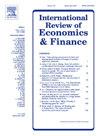Effect of firm social status on ESG performance: Theoretical mechanism and heterogeneity analysis
IF 4.8
2区 经济学
Q1 BUSINESS, FINANCE
引用次数: 0
Abstract
Firm social status affects decision-making and external stakeholders' evaluation, which affects ESG performance. Drawing upon the perspective of firm social attributes, we empirically examine the effect of firm social status on ESG performance and the mechanism. Our sample comprises Chinese-listed firms in Shanghai and Shenzhen A-shares. Our findings indicate that firms with high social status can significantly improve ESG performance. Both media coverage and high-speed rail lines positively moderate the relationship between firm social status and ESG performance. The test for mediated effects reveals that firm social status promotes firms' ESG performance by reducing financing constraints and increasing information transparency. Using Heckman's two-stage model and propensity score matching to address the endogeneity concern and robustness testing by changing data sources and alternative measures for variables, the positive effect of firm social status on ESG performance still holds. The heterogeneity analysis shows that the effect of firm social status on ESG performance is more pronounced for low independent directors' share firms, non-state-owned enterprises (non-SOEs), low environmental attention firms, non-heavily polluting firms, and competitive industry firms. We further demonstrate that ESG performance mediates the relationship between firm social status and innovation.
企业社会地位对ESG绩效的影响:理论机制与异质性分析
企业社会地位影响决策和外部利益相关者评价,进而影响ESG绩效。本文借鉴企业社会属性的视角,实证考察了企业社会地位对企业ESG绩效的影响及其作用机制。我们的样本包括在上海和深圳a股上市的中国公司。研究结果表明,社会地位高的企业能够显著提高企业的ESG绩效。媒体报道和高铁对企业社会地位与ESG绩效的关系均有正向调节作用。中介效应检验表明,企业社会地位通过降低融资约束和提高信息透明度来促进企业ESG绩效。利用Heckman的两阶段模型和倾向得分匹配,通过改变数据源和变量的替代度量来解决内生性问题和稳健性检验,企业社会地位对ESG绩效的积极影响仍然存在。异质性分析表明,企业社会地位对企业ESG绩效的影响在独立董事持股比例低的企业、非国有企业、环境关注度低的企业、非重度污染企业和竞争性行业企业中更为显著。我们进一步证明ESG绩效在企业社会地位与创新之间具有中介作用。
本文章由计算机程序翻译,如有差异,请以英文原文为准。
求助全文
约1分钟内获得全文
求助全文
来源期刊
CiteScore
7.30
自引率
2.20%
发文量
253
期刊介绍:
The International Review of Economics & Finance (IREF) is a scholarly journal devoted to the publication of high quality theoretical and empirical articles in all areas of international economics, macroeconomics and financial economics. Contributions that facilitate the communications between the real and the financial sectors of the economy are of particular interest.

 求助内容:
求助内容: 应助结果提醒方式:
应助结果提醒方式:


